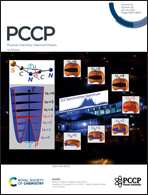The influence of fluorination on the dynamics of the F− + CH3CH2I reaction
Abstract
The competition between the bimolecular nucleophilic substitution (SN2) and base-induced elimination (E2) reaction and their intrinsic reactivity is of key interest in organic chemistry. To investigate the effect of suppressing the E2 pathway on SN2 reactivity, we compared the reactions F− + CH3CH2I and F− + CF3CH2I. Differential cross-sections have been measured in a crossed-beam setup combined with velocity map imaging, giving insight into the underlying mechanisms of the individual pathways. Additionally, we employed a selected-ion flow tube to obtain reaction rates and high-level ab initio computations to characterize the different reaction pathways and product channels. The fluorination of the β-carbon not only suppresses the E2-reaction but opens up additional channels involving the abstraction of fluorine. The overall SN2 reactivity is reduced compared to the non-fluorinated iodoethane. This reduction is presumably due to the competition with the highly reactive channels forming FHF− and CF2CI−.

- This article is part of the themed collections: Molecular Dynamics in the Gas Phase and 2023 PCCP HOT Articles


 Please wait while we load your content...
Please wait while we load your content...